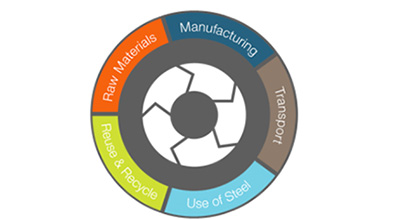
BlueScope believes that evaluating any product or service for environmental sustainability needs to include impacts and credits from throughout the full life cycle. Life Cycle Assessment (LCA) is an internationally recognised standardised method for assessing environmental impacts through the life of a product.
Measures that limit evaluation to 'embodied' impacts from raw materials and/or manufacturing, do not assess the impact of material choice on transportation, use, reuse or recycling.
Raw Materials
Choices in raw materials supply for steel manufacture can deliver higher quality steel, more efficient production and a lower environmental footprint. BlueScope manages raw materials in a number of ways, for example at the Port Kembla Steelworks:
- every steel product is guaranteed to contain recycled content;
- continuing focus on continuous improvement is assisting to maximise production efficiency;
- chlorides in iron ore are being minimised to reduce emissions;
- low ash content and blending iron ores are enabling consistent quality production, reducing waste;
- material use efficiencies are consistently above 96 per cent.
Manufacturing
BlueScope works to improve the environmental footprint of its manufacturing process, for example at the Port Kembla Steelworks:
- Waste gases are used to generate electricity and energy for production processes;
- Waste management strategies begin with minimising waste generation. Where waste is generated, the maximum practical benefits from waste by-products are extracted, such as process dusts and sludges, and slag;
- BlueScope aims for zero dam water use. Salt water makes up 96% of the water used in manufacturing and recycled water makes up nearly all other fresh water manufacturing requirements; and
- BlueScope invests in new technologies to improve manufacturing processes, for example the Company is leading an investigation into the use of biochar, a form of charcoal, to reduce carbon emissions.
Use
How a product is used can have a significant influence on whole of life impacts.
In the case of buildings, materials directly contribute to the natural comfort of living areas (warm in winter or cool in summer), how energy efficient or electricity hungry the structure is, resilience to pests such as termites, and resilience to everyday conditions affecting maintenance over the life of the building.
In recent times some designers have chosen to rate materials based on the embodied impact per unit of mass. This simplistic assessment fails to produce an environmentally sustainable outcome as it does not consider material efficiency. Steel’s high strength to weight ratio requires less material than some other materials in like applications, resulting in dematerialisation of a structure. For example 1 kg of COLORBOND® steel would likely clad an area approximately nine times greater than 1 kg of concrete roof tiles would be able to cover, resulting not only in less mass in the roof structure, but potentially less mass in the support structure.
Another area of increasing interest globally is housing designed for resilience to extreme weather events. A house designed for resilience, using resilient materials, is more likely to remain habitable in the wake of extreme weather, even if damaged. BlueScope Steel products can improve the resilience of the built environment, for example:
- HEAT WAVES: BlueScope Steel roofing and cladding with Thermatech® solar reflectance technology reduces the amount of solar radiation (and consequently heat) absorbed into buildings. This, combined with steel's low thermal mass, can assist building interiors to remain comfortable even when there is no access to electricity and no relief from cooler night temperatures.
- DROUGHT and STORMWATER: AQUAPLATE® steel rainwater harvesting systems help maintain local water supply in times of reduced rainfall as well as reduce stormwater flow during rain events.
- FLOOD: High strength TRUECORE® steel framing is less likely to be overwhelmed by floodwaters than some other materials that can be used for the same purpose. Steel structures have been found to require less maintenance post-flood.
- BUSHFIRE: Independent testing has found steel products to be more resistant to fire than other materials used for the same purpose.
- HIGH WINDS: Fixing systems for steel roofs perform well in high winds and curved roofs help mitigate some of the stresses on buildings from strong winds.
- HAIL: NRMA testing shows that steel can withstand larger hail for longer than typical alternative products, which not only reduces the risk of roof penetration, but as a result also gives a greater level of protection for building contents.
End of Life
The right choice of materials has consequences for future generations.
Firstly, materials should be durable and designed for the local environment where they will be used. This maximises the use phase of a product’s life cycle.
Secondly, after the initial use phase has reached its end, materials should be reused. This is made easier if the initial use phase design has catered for reuse.
Finally, end of life options should be considered. Materials that are 100% recyclable with a proven recycling performance reduce the amount of waste sent to landfill and reduce impacts on future generations. Steel is the world's most recycled material, being theoretically 100% recyclable, and its magnetic properties make it easy to recover. There is a dynamic market for recycled steel, which is an essential ingredient in the manufacture of new steel.
BlueScope's sustainability website has more information about Life Cycle Assessment.
